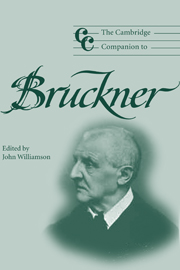Book contents
- Frontmatter
- Part I Background
- Part II Choral music
- Part III The symphonist
- 7 The Brucknerian symphony: an overview
- 8 Bruckner's symphonies – a reinterpretation: the dialectic of darkness and light
- 9 Programme symphony and absolute music
- 10 Bruckner editions: the revolution revisited
- 11 Bruckner and the symphony orchestra
- 12 Between formlessness and formality: aspects of Bruckner's approach to symphonic form
- 13 Formal process as spiritual progress: the symphonic slow movements
- 14 Bruckner and harmony
- Part IV Reception
- Notes
- Select bibliography
- Index
14 - Bruckner and harmony
from Part III - The symphonist
Published online by Cambridge University Press: 28 September 2011
- Frontmatter
- Part I Background
- Part II Choral music
- Part III The symphonist
- 7 The Brucknerian symphony: an overview
- 8 Bruckner's symphonies – a reinterpretation: the dialectic of darkness and light
- 9 Programme symphony and absolute music
- 10 Bruckner editions: the revolution revisited
- 11 Bruckner and the symphony orchestra
- 12 Between formlessness and formality: aspects of Bruckner's approach to symphonic form
- 13 Formal process as spiritual progress: the symphonic slow movements
- 14 Bruckner and harmony
- Part IV Reception
- Notes
- Select bibliography
- Index
Summary
Analysts of late nineteenth-century chromatic harmony must often reconcile both the conservative and progressive aspects of the music. On the one hand, the music has a venerable history to which it is indebted; on the other, musical works are subject to the creativity of individual musical voices, with resultant effect on tonal relations. This situation presents a problem that is perhaps more difficult than a first glance might suggest. In deference to its history, a sensitive analyst might opt to mimic the historical process by applying tried-and-true analytical techniques that have served so well for earlier musical styles. An equally sensitive analyst may be drawn to the opposite pole; in an effort to capture the music's forward-looking, individual nature, an analyst may apply newer methodologies, adapting them to account for the music's veiled tonality.
Certainly, it is a truism that an analytical methodology will return results that betray its bias. For example, Edward Laufer accounts for many of Bruckner's bold harmonic progressions by illustrating how a traditional classical model might be distorted to produce the end result. One of the techniques that Laufer insightfully asserts to be typically Brucknerian is ‘elision’, the process whereby a composer omits essential voices in a texture that provide the understood consonant support for a prolongation. The musical texture present is shown to take its meaning from a set of passing tones originating in a traditional, yet unstated harmonic model. Thus, Laufer's analytical technique is used to normalize Bruckner's composition to a classical model.
- Type
- Chapter
- Information
- The Cambridge Companion to Bruckner , pp. 205 - 228Publisher: Cambridge University PressPrint publication year: 2004
- 4
- Cited by



